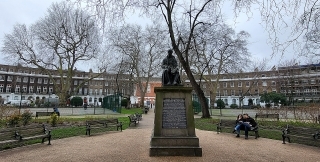A statue, a reformer, and a crescent in London
LONDON IS FULL of reminders of the past. Almost wherever you go, you will come across a memorial (be it a plaque on a wall, or a monument, or a statue, or even a street name) to someone or something of historical interest. Today, the 20th of February 2024, after spending a pleasant hour with my friend Royden Clogstoun (related to the Victorian photographer Julia Margaret Cameron) at the British Library, I walked to Twinings tea shop, which is on the Strand (opposite the Royal Courts of Justice). I began heading south along Mabledon Place, which soon becomes named as Cartwright Gardens. This road runs along the straight edge of a green space shaped like a segment of a circle. The green space is bounded by a road that forms part of a circle – this is also called Cartwright Gardens. Until 1908, this crescent-shaped road was called Burton Crescent in honour of its developer James Burton (1761-1837).

Many of the buildings on the crescent are now hotels. The green space contains tennis courts and a bronze statue. This monument was added to the open space – the garden of Cartwright Gardens – in 1831, that is about 20 years after the area was developed. The statue depicts Major John Cartwright (1740-1824), who lived for a time in what was then Burton Crescent. Born in Marnham (Nottinghamshire), he served in the Royal Navy from the age of 18. In 1771, he retired from the navy for a time for health reasons.
When the colonists in the North American colonies began to rebel against their British rulers, Cartwright refused an appointment in the armed forces because he believed that the colonists had just reasons for their cause. In 1774, he wrote “”American Independence the Glory and Interest of Great Britain.”, which was a plea in favour of the colonists. According to the plaque beneath his statue, he was:
“…the first English writer, who openly maintained the Independence of the United States of America …”
And, furthermore, he:
“… he nobly refused to draw his Sword against the Rising Liberties of an oppressed and struggling People …”
Yet, this is not all he did in the face of existing conventions of his time. He was an active campaigner for parliamentary reform. His goal was to introduce secret ballots and universal suffrage (for men) – to give all men the right to vote in parliamentary elections. He did not live long enough to see his goal attained. For, it was only in 1918 that the Representation of the People Act was passed in Parliament. This allowed all men aged over 21 to vote regardless of the value of their property, and women aged over 30 provided their residence had a rateable value of over £5.
I knew nothing about John Cartwright and his remarkable outlook on life until I stopped to look at his statue today. However, I knew about his younger brother Edmund Cartwright (1743-1823). He invented the power loom, one of the machines that paved the way for the industrialisation of textile production and helped the birth of Britain’s so-called Industrial Revolution.
Had I taken a bus from the British Library to the Strand, instead of walking leisurely, I would not have passed through Cartwright Gardens, and it might have been a long time before I became aware of John Cartwright and his revolutionary ideas.



